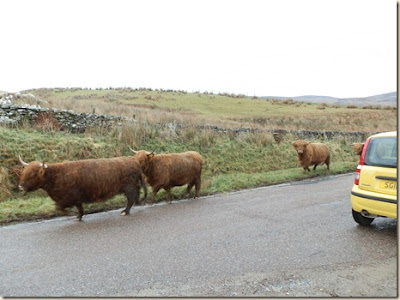Progress on scraping blue paint from Cirrus’ bottom continues slowly and tiresomely, the job being made less pleasant by a fine rain which serves to keep the blue dust down but wets the ground on which I kneel. This alternates with bursts of sunshine; as ever the weather here is in constant change.
After many hours scraping I am tired, dirty and damp so I flop back into the car and set off home again. En route, as I cross the highest point of the Kintyre peninsula, a lady dressed in rough clothing steps out into the middle of the single track road, waving me to a halt, so I pull over and lower the window.
“Can you pull over here please for the Highlanders coming along the road”, she says.
My brain goes into overdrive as I imagine the approaching regiment in full dress uniform, bagpipes blasting out a marching tune and kilts swinging to and fro in time with each step.
Then I think how unlikely such a sight would be in this remote location and I peer ahead down the road to where a large brown animal is just coming into view, a huge pair of horns confronting me. Understanding dawns. These are the Highlanders. A herd of massive hairy ladies and one rather smaller but equally hairy calf come lumbering past us along the road, glancing warily at me as I take the picture. The ladies are all pregnant, I am told, due to give birth in May by which time there will hopefully be a little more warmth about. I bid them farewell and carry on homewards.
The procreation theme continues as in the damp area behind our house, just across the burn (Alt na Caillich or Stream of the Old Woman), there is evidence of an outburst of froggy promiscuity as the spawn bubbles up thickly forming small hillocks on the surface of a pool. Further away beside the forest track there are larger pools where frogspawn lies in dark masses and newts patrol the clear water around this like jackals weighing up their prey. There must be a balance here – the newts falling prey to something larger perhaps or maybe their bellies simply cannot accommodate all the tiny hatchlings before they grow large enough to defend themselves. Chaffinches are at it too, dividing their time now between our feeders and the task of collecting dried grass stems for their nests and sheep grazing beside the road leading down to Carradale bay appear more solid than usual, full to bursting with this year’s lambs.
Carradale Point offers another spectacle to those who are prepared to risk injury clambering over the jumble of rocks out on the end. Our feral goats are looking particularly stunning just now but to get a close look stealth is required as they are always alert to the slightest sound or movement. The landscape here offers plenty of opportunities for creeping up on them though – large tilted boulders to hide behind then peer over or else stay low and lift the camera up high enough to get a clear shot. Struggling around one obstacle I startle a heron standing up to its ankles in a shallow pool, waiting for his lunch to appear, no doubt. I am not sure who is more surprised, the bird or me, but it takes off away from me with much straining of its great muscles. Not having been this close to a heron before, less than 2 metres, I was struck by how little flesh there appears to be on the bird. The neck is stretched thinly out ahead as the bird strains for elevation and the body is no more than a swelling located some way further aft. The most spectacular feature is, of course, the wings that whistle downwards through the air on each stroke. When standing upright on the ground the eyes of an adult bird would be almost level with mine yet despite their size they build nests in the topmost tree branches, typically of conifers, from where their fledglings will sit and squawk monotonously all day long. I have always found the idea of our larger species of bird nesting in trees somewhat hard to comprehend. Years ago I was taken aback to discover that a peacock, a ground-loving bird ludicrously over-endowed with plumage, will roost in a tree at night. Which perhaps proves that gravity is not all it is cracked up to be.



No comments:
Post a Comment